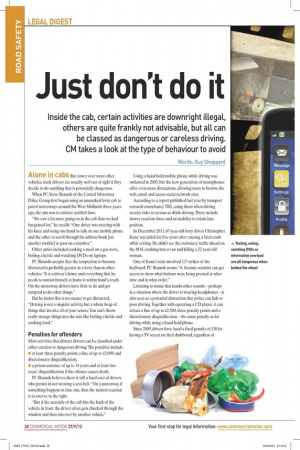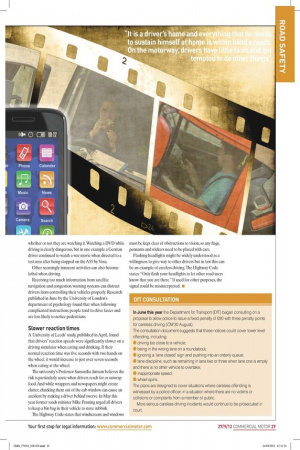Just don’t do it
Page 20

Page 21

If you've noticed an error in this article please click here to report it so we can fix it.
Inside the cab, certain activities are downright illegal, others are quite frankly not advisable, but all can be classed as dangerous or careless driving. CM takes a look at the type of behaviour to avoid
Words: Guy Sheppard Alone in cabs that tower over most other vehicles, truck drivers are usually well out of sight if they decide to do anything that is potentially dangerous.
When PC Steve Rounds of the Central Motorway Police Group irst began using an unmarked lorry cab to patrol motorways around the West Midlands three years ago, the aim was to enforce seatbelt laws.
“We saw a lot more going on in the cab than we had bargained for,” he recalls. “One driver was steering with his knee and using one hand to talk on one mobile phone and the other to scroll through his address book [on another mobile] to pass on a number.” Other antics included cooking a meal on a gas stove, boiling a kettle and watching DVDs on laptops.
PC Rounds accepts that the temptation to become distracted is probably greater in a lorry than in other vehicles. “It is a driver’s home and everything that he needs to sustain himself at home is within hand’s reach. On the motorway, drivers have little to do and get tempted to do other things.” But he insists this is no excuse to get distracted. “Driving is not a singular activity, but a whole heap of things that involve all of your senses. You can’t throw really strange things into the mix like boiling a kettle and cooking food.”
Penalties for offenders
Most activities that distract drivers can be classiied under either careless or dangerous driving. The penalties include: • at least three penalty points, a ine of up to £5,000 and discretionary disqualiication; • a prison sentence of up to 14 years and at least two years’ disqualiication if the offence causes death.
PC Rounds believes there is still a hard core of drivers who persist in not wearing a seat belt. “On a motorway, if something happens in lane one, then the natural reaction is to swerve to the right.
“But if the nearside of the cab hits the back of the vehicle in front, the driver often gets chucked through the window and then run over by another vehicle.” Using a hand-held mobile phone while driving was outlawed in 2003, but the new generation of smartphones offer even more distractions, allowing users to browse the web, email and access social network sites.
According to a report published last year by transport research consultancy TRL, using them when driving creates risks as serious as drink-driving. These include slower reaction times and an inability to retain lane position.
In December 2011, 67-year-old lorry driver Christopher Kane was jailed for ive years after causing a fatal crash while texting. He didn’t see the stationary trafic ahead on the M18, crashing into a van and killing a 22-year-old woman.
One of Kane’s texts involved 117 strikes of the keyboard. PC Rounds warns: “A forensic scientist can get access to show what buttons were being pressed at what time and in what order.” Listening to music that masks other sounds – perhaps in a situation where the driver is wearing headphones – is also seen as a potential distraction that police can link to poor driving. Together with operating a CD player, it can attract a ine of up to £2,500, three penalty points and a discretionary disqualiication – the same penalty as for driving while using a hand-held phone.
Since 2009, drivers have faced a ixed penalty of £30 for having a TV screen on their dashboard, regardless of whether or not they are watching it. Watching a DVD while driving is clearly dangerous, but in one example a German driver continued to watch a war movie when directed to a test area after being stopped on the A55 by Vosa.
Other seemingly innocent activities can also become lethal when driving.
Receiving too much information from satellite navigation and congestion warning systems can distract drivers from controlling their vehicles properly. Research published in June by the University of London’s department of psychology found that when following complicated instructions people tend to drive faster and are less likely to notice pedestrians.
Slower reaction times
A University of Leeds’ study, published in April, found that drivers’ reaction speeds were signiicantly slower on a driving simulator when eating and drinking. If their normal reaction time was ive seconds with two hands on the wheel, it would increase to just over seven seconds when eating at the wheel.
The university’s Professor Samantha Jamson believes the risk is particularly acute when drivers reach for or unwrap food. And while wrappers and newspapers might create clutter, chucking them out of the cab window can cause an accident by making a driver behind swerve. In May this year former roads minister Mike Penning urged all drivers to keep a bin bag in their vehicle to store rubbish.
The Highway Code states that windscreens and windows must be kept clear of obstructions to vision, so any lags, pennants and stickers need to be placed with care.
Flashing headlights might be widely understood as a willingness to give way to other drivers but in law this can be an example of careless driving. The Highway Code states: “Only lash your headlights to let other road users know that you are there.” If used for other purposes, the signal could be misinterpreted. ■
DfT CONSULTATION
In June this year the Department for Transport (DfT) began consulting on a proposal to allow police to issue a fixed penalty of £90 with three penalty points for careless driving (CM 30 August).
The consultation document suggests that these notices could cover lower level offending, including: • driving too close to a vehicle; • being in the wrong lane on a roundabout; • ignoring a ‘lane closed’ sign and pushing into an orderly queue; • lane discipline, such as remaining in lane two or three when lane one is empty and there is no other vehicle to overtake; • inappropriate speed; • wheel spins.
The plans are designed to cover situations where careless offending is witnessed by a police officer, in a situation where there are no victims or collisions or complaints from a member of public.
More serious careless driving incidents would continue to be prosecuted in court.










































